Are Ecological Design Principles Becoming the Norm in Contemporary Landscape Design? A Comparative Analysis of Realized Park Projects (2015–2025)
Abstract
1. Introduction
2. Materials and Methods
2.1. Materials
2.1.1. Theoretical Framework
2.1.2. Empirical Project Dataset
- Case Study Selection Criteria
- -
- Realized between 2015 and 2025
- -
- Explicitly labeled as a park (excluding “residential parks”)
- -
- Accompanied by a written explanation
- Site Classification
- Supporting Visual Materials
2.2. Methods
2.2.1. Content Analysis of Project Narratives
2.2.2. Design Composition Analysis
2.2.3. Descriptive Statistics
2.3. Limitations
3. Theoretical Framework
3.1. Landscape Architecture and Landscape Design
3.2. The Concept of Ecological Design
- Sustainability or sustainable development is commonly defined as“ development that meets the needs of the present without compromising the ability of future generations to meet their own needs” [62].
- Conservation generally refers to the sustainable use of natural resources aimed at maintaining renewable stocks for human needs [63].
- Ecological restoration involves repairing degraded ecosystems by restoring their structure and function.
- Ecosystem management entails managing areas of all sizes to preserve ecosystem services and biological resources while maintaining human needs [64].
- Resilience refers to a system’s capacity either to recover after change (general resilience) or to maintain its functions despite external disturbances (ecological resilience) [65]. Therefore, fully functioning ecosystems are both resilient and capable of self-repair.
- One of the most significant paradigms shifts since the rise of sustainability in the mid-1980s is the growing focus on ecological restoration—a new paradigm assuming that ecosystem degradation is not permanent or irreversible [69]. Closely tied to this shift is the emergence of Landscape Sustainability Science (LSS)—a place-based and use-inspired discipline aiming to understand and enhance sustainability for nature and people [70]. LSS is vital for exploring transitions and transformation toward resilience and sustainability, but it requires full integration with landscape design/planning practice through a transdisciplinary collaboration, therefore bridging disciplines, fostering communication between scientists and practitioners, and engaging stakeholders in knowledge co-creation [55].
- Taken together, these developments illustrate that ED has evolved into a broad, interdisciplinary field that is firmly rooted in sustainability, system thinking and regenerative practices. Recent developments—such as regenerative development/design, ecological restoration and LSS—highlight its growing relevance and signal a shift toward more integrative and transformative approaches.
3.3. Ecological Design Principles
4. Results/Case Study Analysis (2015–2025)
4.1. Case Study Selection
4.2. Ecological Design Principles Analysis
4.3. Design Composition Analysis and Ecological Design Principle Impact Assessment Analysis
4.3.1. Design Composition Analysis
4.3.2. The Frequency of Ecological Design Principles
4.3.3. Average Scores of Ecological Design Principles
5. Discussion
5.1. Ecological Design Principles
5.2. Design Composition Analysis
6. Conclusions
Funding
Institutional Review Board Statement
Informed Consent Statement
Data Availability Statement
Conflicts of Interest
Abbreviations
| ED | Ecological design |
| LD | Landscape design |
| EDP | Ecological design principle |
| DP | Design principle |
Appendix A
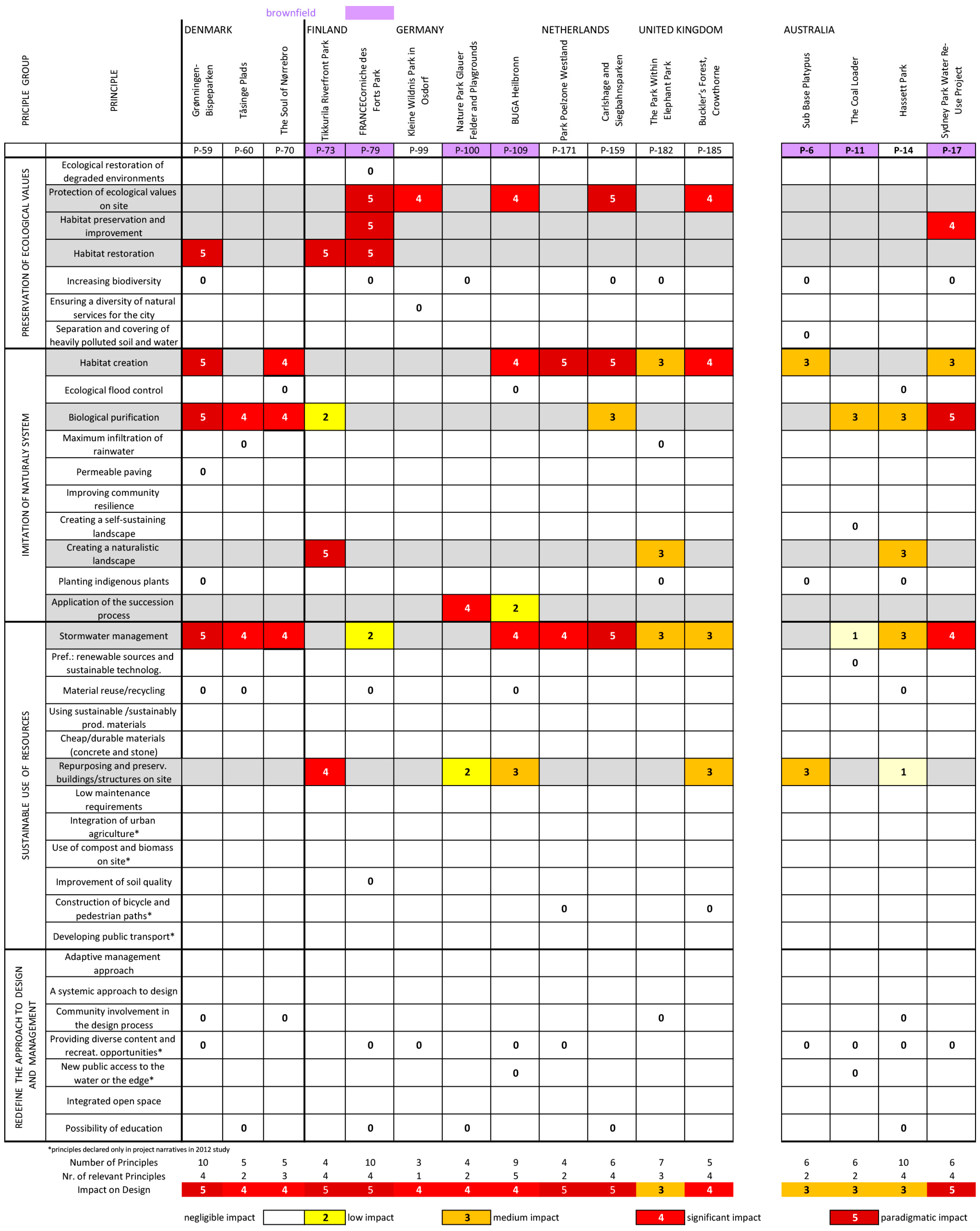
Appendix B
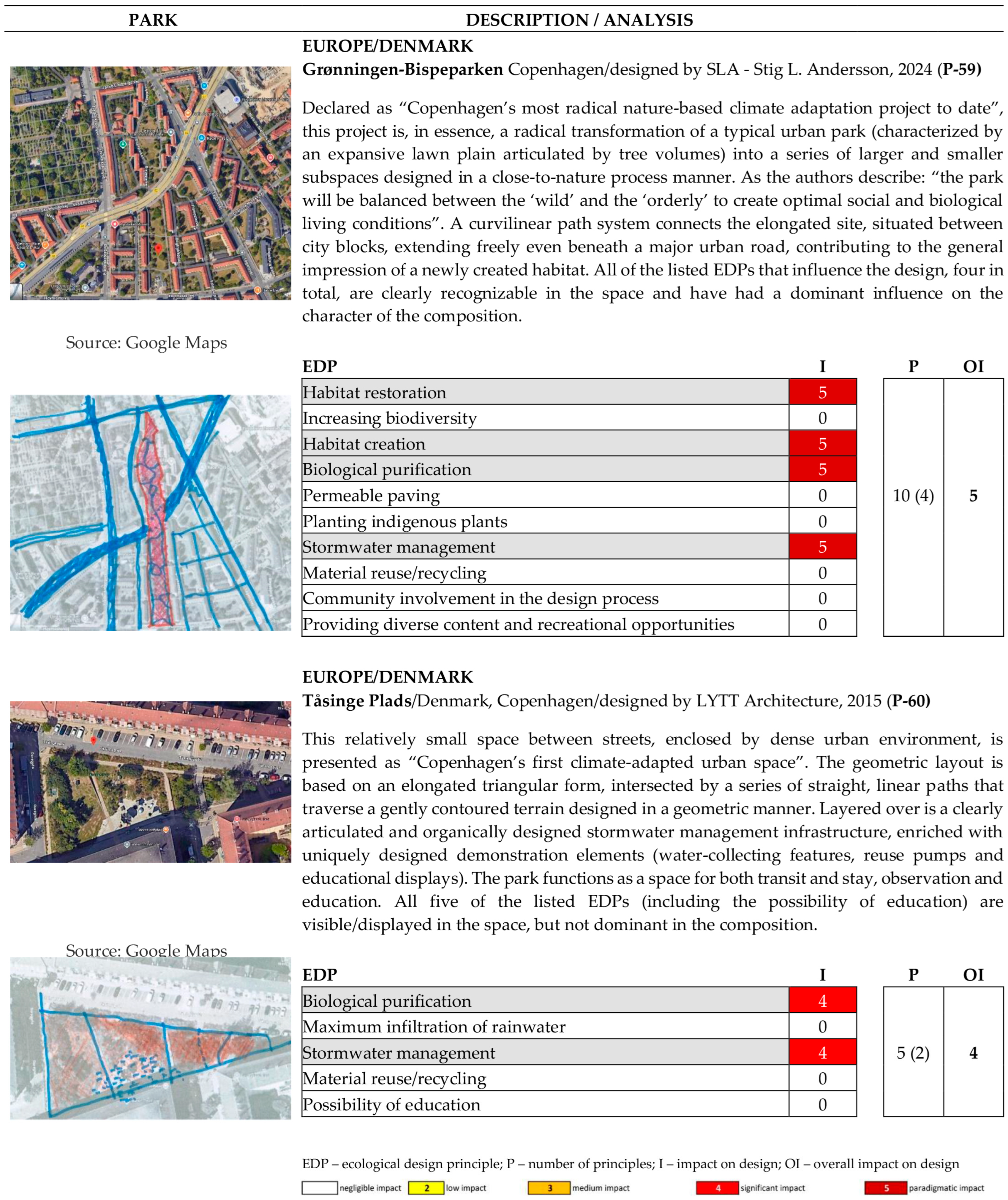

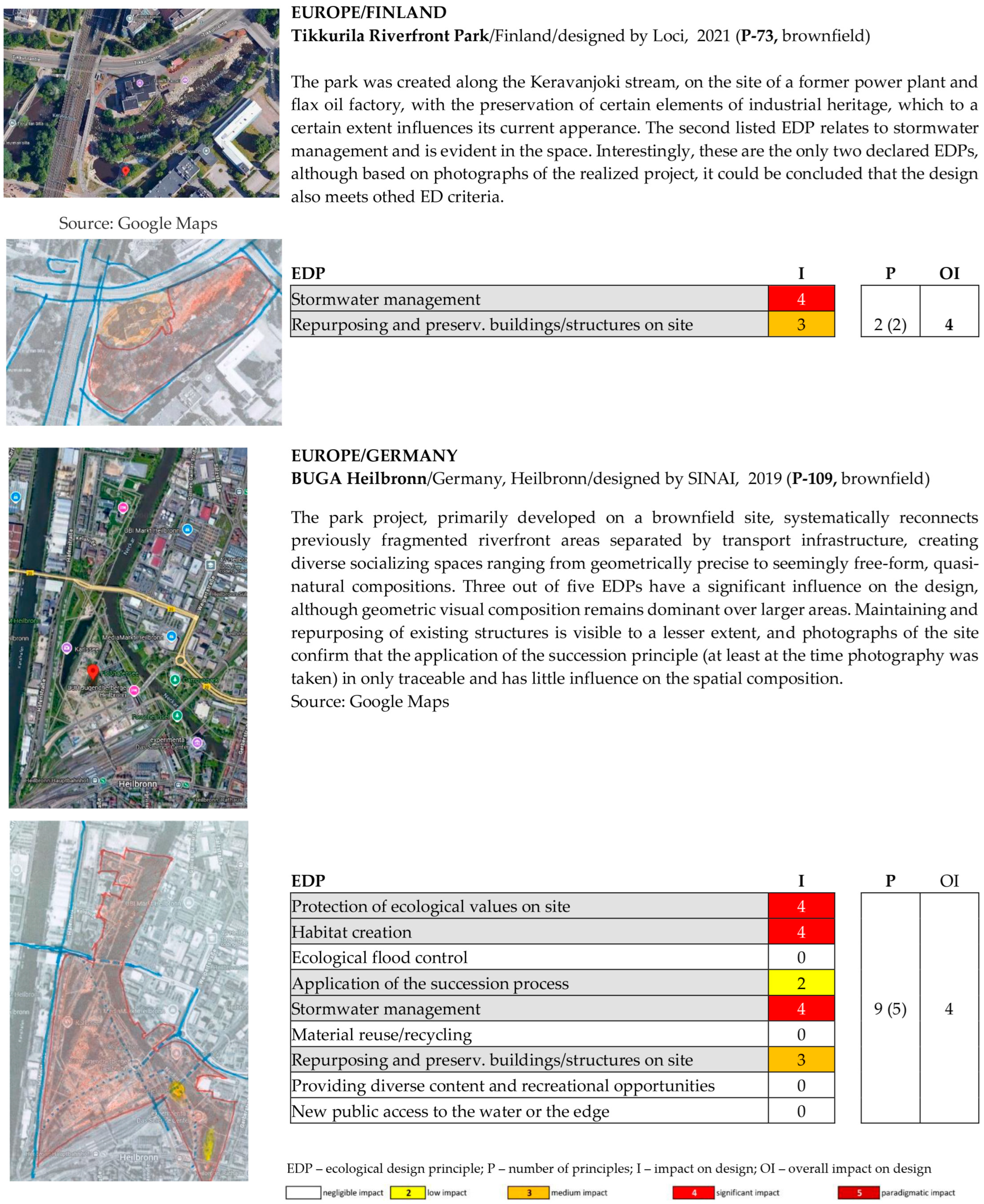

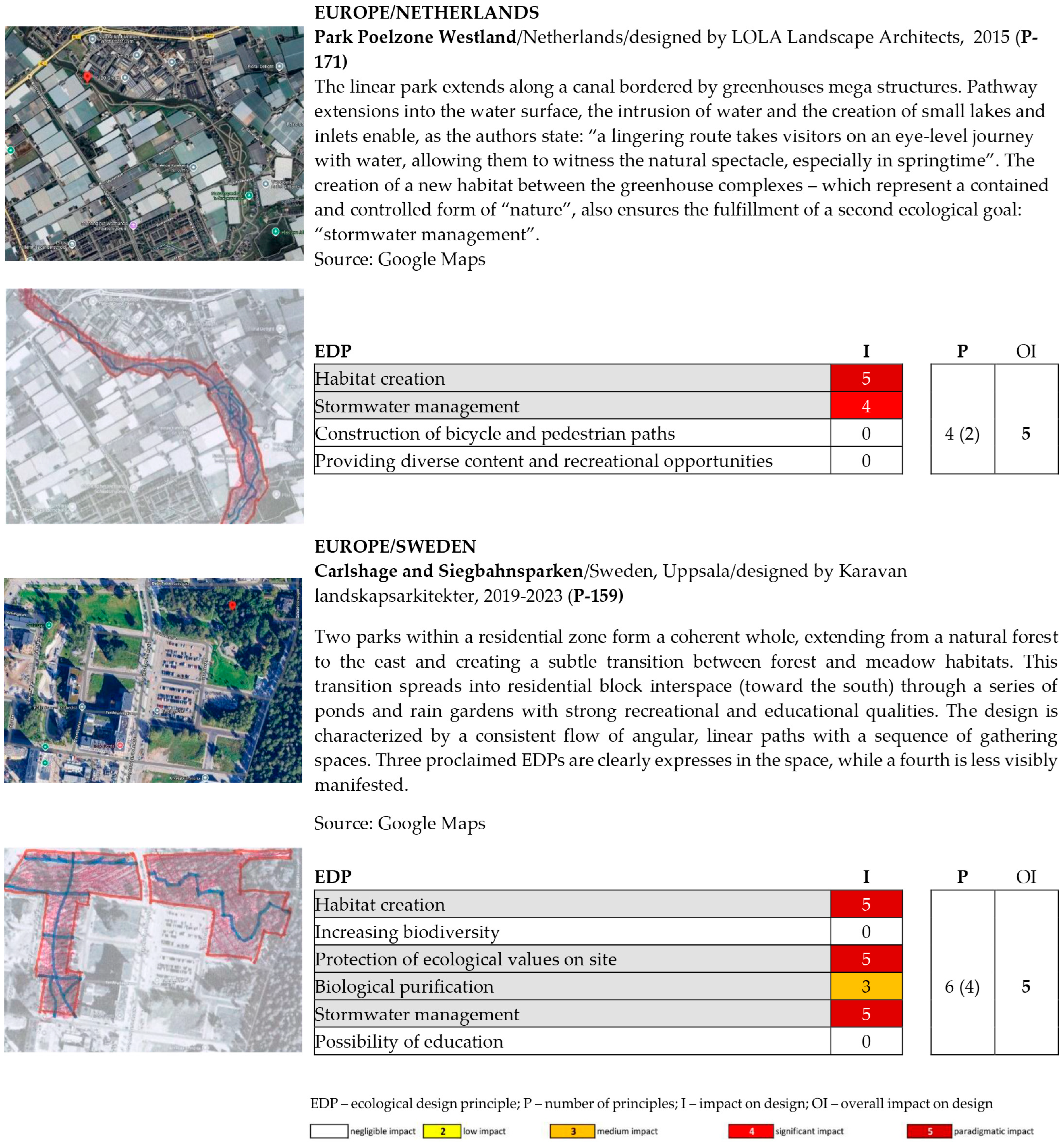

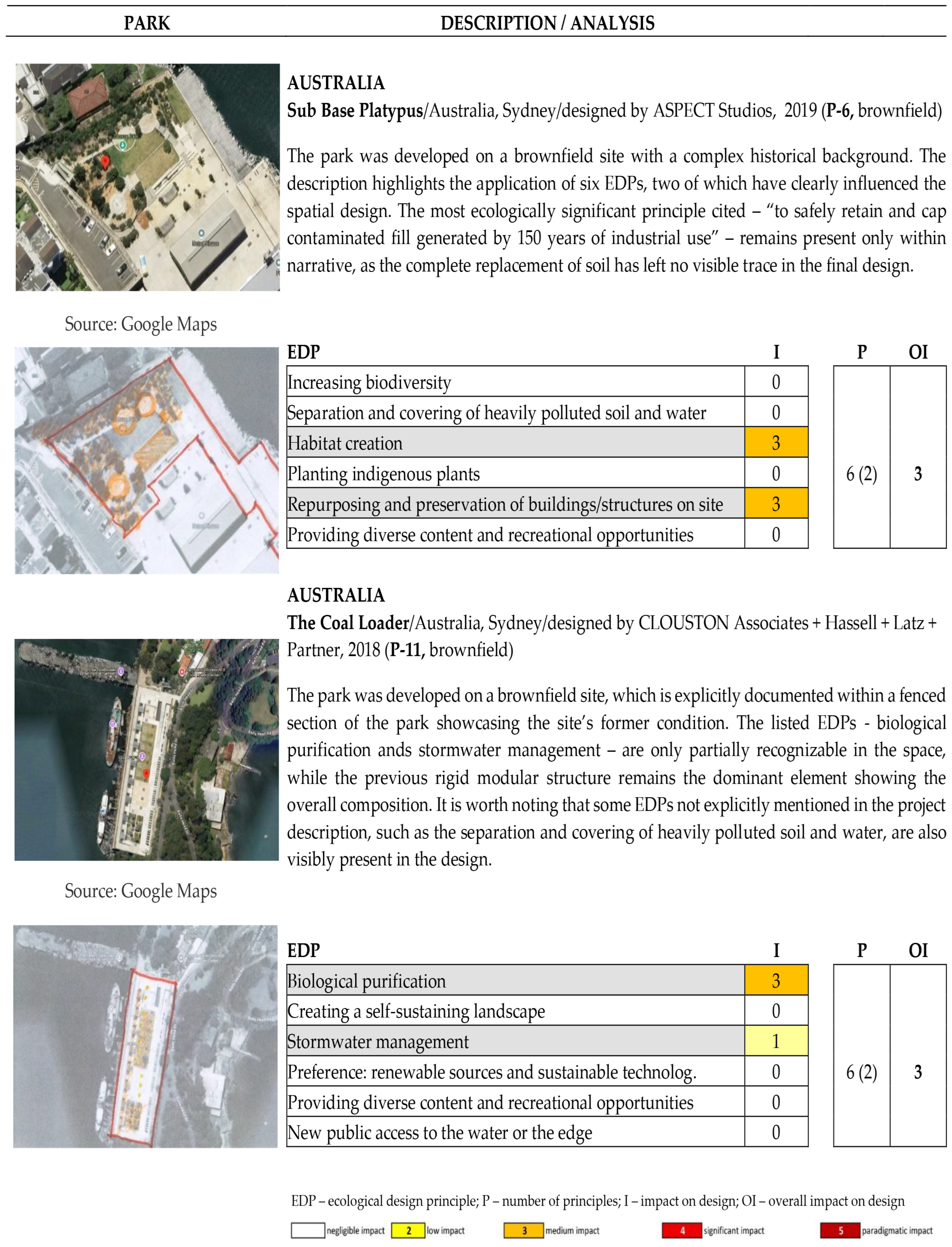
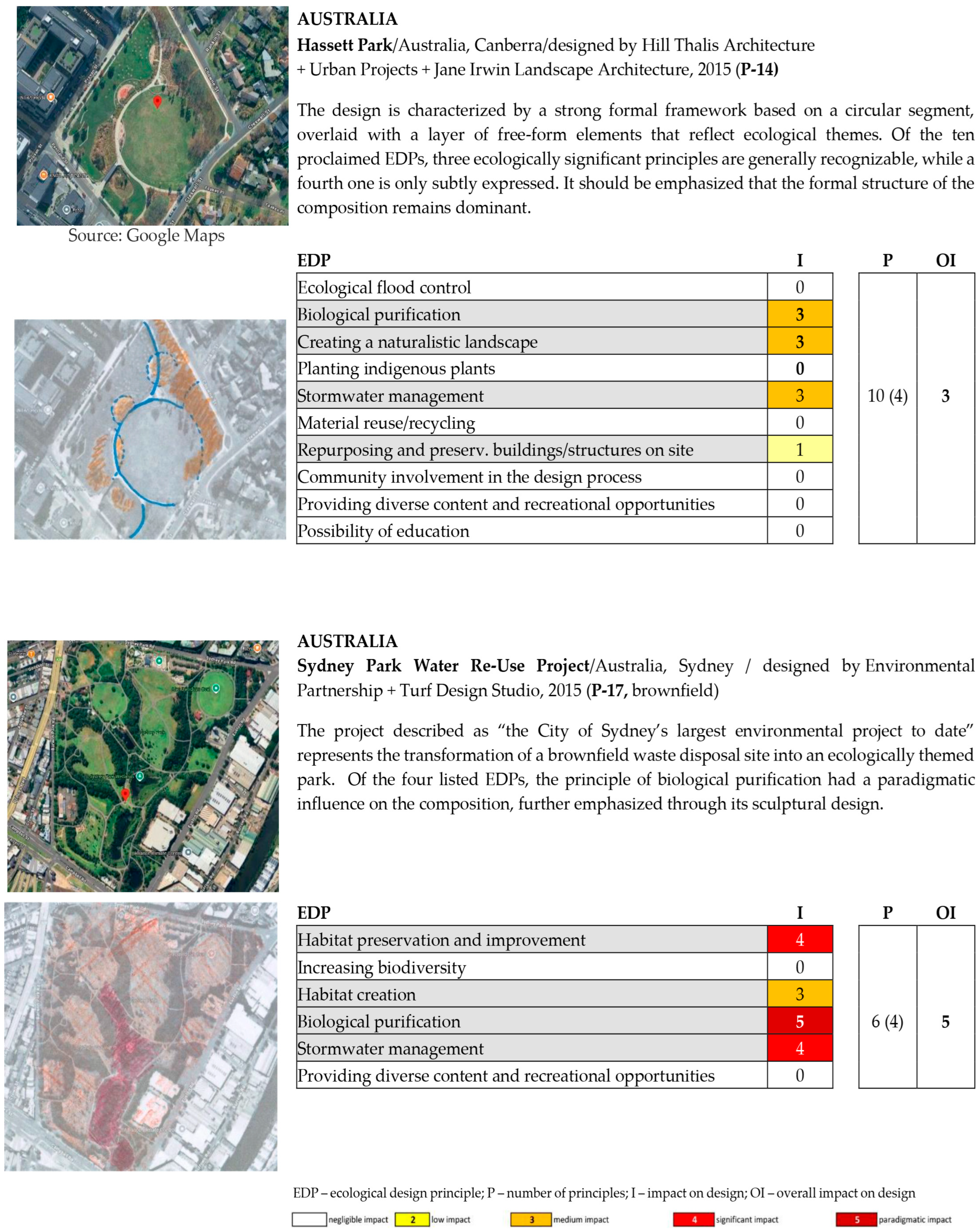
References
- Ndubisi, F. Ecological Planning: A Historical and Comparative Synthesis; The Johns Hopkins University Press: Baltimore, MD, USA, 2002; p. 286. [Google Scholar]
- McNeill, J.R. Something New Under the Sun: An Environmental History of the Twentieth-Century World; W.W. Norton & Company: New York, NY, USA, 2000; p. 448. [Google Scholar]
- Dobson, A. Green Political Thought, 4th ed.; Routledge: London, UK, 2010; p. 240. [Google Scholar]
- Klein, N. This Changes Everything: Capitalism vs. the Climate; Simon & Schuster: New York, NY, USA, 2014; p. 576. [Google Scholar]
- Forman, R.T.T. Urban Ecology: Science of Cities; Cambridge University Press: Cambridge, UK, 2008; p. 476. [Google Scholar]
- Spirn, A.W. The Language of Landscape; Yale University Press: New Haven, CT, USA, 2000; p. 336. [Google Scholar]
- Corner, J. Ecological Urbanism; Mostafavi, M., Doherty, G., Eds.; Lars Müller Publishers: Baden, Switzerland, 2010; pp. 16–29. [Google Scholar]
- Spirn, A.W. The authority of nature: Conflict, confusion and renewal in design, planning and ecology. In Ecology and Design: Frameworks for Learning; Johnson, B.R., Hill, K., Eds.; Island Press: Washington, DC, USA, 2001; pp. 29–50. [Google Scholar]
- Dobrović, N. Savremena arhitektura. In Savremena Arhitektura—Postanak I Poreklo; Građevinska knjiga: Beograd, Yugoslavia, 1965; pp. 7–16. [Google Scholar]
- Jones, P. Architecture, time and cultural politics. Cult. Sociol. 2020, 14, 61–79. [Google Scholar] [CrossRef]
- Porter, B. The Battle of the Styles: Society, Culture and the Design of a New Foreign Office, 1855–1862; Continuum: London, UK, 2011; p. 256. [Google Scholar]
- Frampton, K. Towards Critical Regionalism: Six points for an architecture of resistance. In the Anti-Aesthetic: Essays on Postmodern Culture; Foster, H., Ed.; Bay Press: Port Townsend, WA, USA, 1983; pp. 16–30. [Google Scholar]
- Mohorovičić, A. Teoretska analiza arhitektonskog oblikovanja (izvadak). In Programi I Manifesti Arhitekture xx. Stoljeća; Rogina, K., Ed.; Biblioteka Psefizma: Zagreb, Croatia, 1947; pp. 326–328. [Google Scholar]
- Mutnjaković, A. Arhitektura kao tehnika i kao umjetnost. In Programi I Manifesti Arhitekture xx. Stoljeća; Rogina, K., Ed.; Biblioteka Psefizma: Zagreb, Hrvatska, 1997; pp. 389–395. [Google Scholar]
- Mohorovičić, A. Prilog Analizi Nekih Osnovnih Problema Teorije Arhitekture: O Kategorijama Apsolutnog I Relativnog U Teoriji Arhitekture. Ph.D. Thesis, University of Zagreb, Zagreb, Croatia, 1975. [Google Scholar]
- Mitchell, W.J.T. What Do Pictures Want? The Lives and Loves of Images; University of Chicago Press: Chicago, IL, USA, 2005; p. 408. [Google Scholar]
- Treib, M. The Architecture of Landscape, 1940–1960; University of Pennsylvania Press: Philadelphia, PA, USA, 2002; p. 328. [Google Scholar]
- Beatley, T. Green Urbanism: Learning From European Cities; Island Press: Washington, DC, USA, 1999; p. 512. [Google Scholar]
- Wheeler, S.M. Planning for Sustainability: Creating Livable, Equitable and Ecological Communities; Routledge: London, UK, 2013; p. 424. [Google Scholar]
- Liu, Y. Ecological Sustainable Landscape Design from Modern and Contemporary Perspectives: Characteristics, Practices; and Future Trends. In Highlights in Art and Design; Darcy & Roy Press: Hillsboro, OR, USA, 2025; Volume 9, pp. 77–80. [Google Scholar] [CrossRef]
- Ahern, J. Green infrastructure for cities: The spatial dimension. In Cities of the Future: Towards Integrated Sustainable Water and Landscape Management; Novotny, V., Brown, P., Eds.; IWA Publishing: London, UK, 2007; pp. 267–278. [Google Scholar]
- Rechner Dika, I. Ekološko oblikovanje kao paradigma suvremenog krajobraznog oblikovanja. Ecological Design as a Paradigm of a Contemporary Landscape Design. Ph.D. Thesis, University of Zagreb Faculty of Agriculture, Zagreb, Croatia, 2012. [Google Scholar]
- Richardson, T. Futurescapes—Designers for Tomorrow′s Outdoor Spaces; Thames & Hudson: London, UK, 2011; p. 351. [Google Scholar]
- Jellicoe, G.A. Studies in Landscape Design; Oxford University Press: London, UK, 1960; p. 112. [Google Scholar]
- Gustavsson, E. Art and ethics in landscape architecture. In ECLAS Conference Proceedings; ECLAS: Dubrovnik, Croatia, 2000; pp. 187–192. [Google Scholar]
- Steiner, F. Landscape architecture. In International Encyclopedia of the Social & Behavioral Sciences; Elsevier: Oxford, UK, 2004; pp. 8270–8275. [Google Scholar]
- Forman, R.T.T. The missing catalyst: Design and planning with ecology roots. In Ecology and Design: Frameworks for Learning; Johnson, B.R., Hill, K., Eds.; Island Press: Washington, DC, USA, 2001; pp. 85–110. [Google Scholar]
- Marušič, I. Dilemmas in the education of landscape architects for the 21st century. In ECLAS Conference Proceedings; ECLAS: Dubrovnik, Croatia, 2000; pp. 149–160. [Google Scholar]
- Preece, R.A. Designs on the Landscape; Belhaven Press: London, UK, 1991; p. 283. [Google Scholar]
- Murphy, M.D. Landscape Architecture Theory: An Evolving Body of Thought; Waveland Press, Inc.: Long Grove, IL, USA, 2005; p. 256. [Google Scholar]
- Appleton, J.H. The Experience of Landscape; John Wiley & Sons: London, UK, 1986; p. 292. [Google Scholar]
- Bell, S. Elements of Visual Design in the Landscape; E & FN SPON: London, UK, 1993; p. 212. [Google Scholar]
- Nassauer, J.I. Ecological science and landscape design: A necessary relationship in changing landscapes. In Ecology and Design: Frameworks for Learning; Johnson, B.R., Hill, K., Eds.; Island Press: Washington, DC, USA, 2001; pp. 217–230. [Google Scholar]
- Johnson, B.R.; Hill, K. Introduction: Toward landscape realism. In Ecology and Design: Frameworks for Learning; Island Press: Washington, DC, USA, 2001; pp. 1–25. [Google Scholar]
- Thompson, I. Ecology, Community and Delight; University Press: Cambridge, UK, 1999; p. 201. [Google Scholar]
- Baris, M.E. Importance of planning mitigation of the impacts of natural disasters and the part of landscape architects. In ECLAS Conference Proceedings; ECLAS: Dubrovnik, Croatia, 2000; pp. 215–218. [Google Scholar]
- Steinitz, C. On teaching ecological principles to designers. In Ecology and Design: Frameworks for Learning; Johnson, B.R., Hill, K., Eds.; Island Press: Washington, DC, USA, 2001; pp. 231–244. [Google Scholar]
- Karr, J.R. What from ecology is relevant to design and planning? In Ecology and Design: Frameworks for Learning; Johnson, B.R., Hill, K., Eds.; Island Press: Washington, DC, USA, 2001; pp. 133–164. [Google Scholar]
- Celik, F. Ecological Landscape Design. In Advances in Landscape Architecture; InTechOpen: London, UK, 2013; pp. 325–350. [Google Scholar] [CrossRef]
- Gazvoda, D. Characteristics of modern landscape architecture and its education. Landsc. Urban Plan. 2002, 60, 117–133. [Google Scholar] [CrossRef]
- Aničić, B. Krajobrazna arhitektura i stanje u Hrvatskoj. In Proceedings of the Drugi Hrvatski Seminar Perivojne Kulture, Osijek, Croatia, 7–11 October 1997; pp. 6–12. [Google Scholar]
- Ogrin, D. Krajinska Arhitektura; Oddelek za krajinsko Arhitekturo, Biotehniška Fakulteta, Univerza v Ljubljani: Ljubljana, Slovenia, 2010; p. 324. [Google Scholar]
- Hill, K.; White, D.; Maupin, M.; Ryder, B.; Karr, J.R.; Freemark, K.; Taylor, R.; Schauman, S. In expectation of relationships: Centering theories around ecological understanding. In Ecology and Design Frameworks for Learning; Johnson, B.R., Hill, K., Eds.; Island Press: Washington, DC, USA, 2001; pp. 271–304. [Google Scholar]
- Swaffield, S. Theory in Landscape Architecture: A Reader; University of Pennsylvania Press: Philadelphia, PA, USA, 2002; p. 280. [Google Scholar]
- Heymans, A.; Breadsell, J.; Morrison, G.M.; Byrne, J.J.; Eon, C. Ecological Urban Planning and Design: A Systematic Literature Review. Sustainability 2019, 11, 3723. [Google Scholar] [CrossRef]
- Musacchio, L.T. Using the research-through-designing lens to advance landscape sustainability. Landc. Ecol. 2025, 40, 44. [Google Scholar] [CrossRef]
- Van der Ryn, S.; Cowan, S. Ecological Design; Island Press: Washington, DC, USA, 1996; p. 216. [Google Scholar]
- Franklin, C. Fostering living landscapes. In Ecological Design and Planning; Thompson, G.F., Steiner, F., Eds.; John Wiley & Sons, Inc.: New York, NY, USA, 1997; pp. 263–292. [Google Scholar]
- Mohamed, A.S.; Malak, M.N.; Afifi, A. Sustainable approaches to landscape design through diverse environmental waste recycling practices. J. Umm Al Qura Univ. Eng. Archit. 2024, 15, 558–573. [Google Scholar] [CrossRef]
- Calkins, M. Strategy use and challenges of ecological design in landscape architecture. Landsc. Urban Plan. 2005, 73, 29–48. [Google Scholar] [CrossRef]
- Shu-Yang, F.; Freedman, B.; Cote, R. Principles and practice of ecological design. Envir. Rev. 2004, 12, 97–112. [Google Scholar] [CrossRef]
- Smithwick, E.A.H.; Baka, J.; Bird, D.; Blaszcak-Boxe, C.; Cole, C.A.; Fuentes, J.D.; Gergel, S.E.; Glenna, L.l.; Hunt, C.A.; Iulo, L.D.; et al. Regenerative landscape design: An integrative framework to enhance sustainability planning. Ecol. Soc. 2023, 28. [Google Scholar] [CrossRef]
- Hernandez-Santin, C.; Amati, M.; Bekessy, S.; Desha, C. A Review of Existing Ecological Design Frameworks Enabling Biodiversity Inclusive Design. Urban Sci. 2022, 6, 95. [Google Scholar] [CrossRef]
- Hester, R.T. Design for Ecological Democracy; MIT Press: Cambridge, MA, USA, 2006; p. 509. [Google Scholar]
- Rottle, N.; Yocom, K. Ecological Design; AVA Publishing SA: Lausanne, Switzerland, 2010; p. 176. [Google Scholar]
- Ak, B. Principles and applications of ecological landscape design. Turk. J. Landsc. Res. 2024, 7, 213–229. [Google Scholar] [CrossRef]
- Lister, N.M. Sustainable large parks—Ecological design or designer ecology? In Large Parks; Czerniak, J., Hargreaves, G., Eds.; Princeton Architectural Press: New York, NY, USA, 2007; pp. 35–55. [Google Scholar]
- Orr, D. The Nature of Design: Ecology, Culture and Human Intention; Oxford University Press: New York, NY, USA, 2002; p. 237. [Google Scholar]
- Orr, D. Design on the Edge: The Making of a High-Performance Building; MIT Press: Cambridge, MA, USA, 2006; pp. 23–57. [Google Scholar]
- Todd, N.J. Safe and Sustainable World: The Premise of Ecological Design; Island Press: Washington, DC, USA, 2006; p. 203. [Google Scholar]
- Makhzoumi, J.; Pungetti, G. Ecological Design and Planning: The Mediterranean Context; E&FN Spoon: London, UK, 1999; p. 330. [Google Scholar]
- UN. Report of the World Commission on Environment and Development: Our Common Future; UN: New York City, NY, USA, 1987; p. 300. [Google Scholar]
- Hamilton, C.; Macintosh, A. Environmental protection and ecology. In Encyclopedia of Ecology; Jørgensen, S.E., Fath, B.D., Eds.; Elsevier B.V.: Amsterdam, The Netherlands, 2008; pp. 1342–1350. [Google Scholar]
- Brussard, P.F.; Reed, J.M.; Tracy, C.R. Ecosystem management: What is it really? Landsc. Urban Plan. 1998, 40, 9–20. [Google Scholar] [CrossRef]
- Matsinos, Y.G. Resilience. In Encyclopedia of Ecology; Jørgensen, S.E., Fath, B.D., Eds.; Elsevier B.V.: Amsterdam, The Netherlands, 2008; pp. 3000–3009. [Google Scholar]
- Thompson, I.H. The ethics of sustainability. In Landscape and Sustainability; Benson, J.F., Roe, M.H., Eds.; Spon Press: New York, NY, USA, 2000; pp. 15–41. [Google Scholar]
- Windhager, S.; Steiner, F.; Simmons, M.T.; Heymann, D. Toward ecosystem services as a basis for design. Landsc. J. 2010, 29, 107–123. [Google Scholar] [CrossRef]
- Gibbons, L.V. Moving beyond sustainability: A Regenerative Community Development Framework for co-creating thriving living systems and its application. J. Sustain. Dev. 2020, 13, 20–52. [Google Scholar] [CrossRef]
- Usher, M. Restoration as world-making and repair: A pragmatist agenda. Nat. Space 2025, 6, 1252–1277. [Google Scholar] [CrossRef]
- Qiu, J.; Nassauer, J.I.; Ahern, J.; Huang, L.; Reed, J.; Shaogang, D.; Guo, J.; Liu, Z.; Ou, Z.; Shi, P.; et al. Advancing landscape sustainability science: Key challenges and strategies for integration with landscape design and planning. Landsc. Ecol. 2025, 40, 25. [Google Scholar] [CrossRef]
- Cadenasso, M.L.; Pickett, T.A. Urban principles for ecological landscape design and management: Scientific fundamentals. Cities Environ. 2008, 1, 4. Available online: https://digitalcommons.lmu.edu/cate/vol1/iss2/4 (accessed on 1 March 2025). [CrossRef]
- Garvin, A. Sustainability: The key to success. In Public Parks: The Key to Livable Communities; W.W. Norton & Company, Inc.: New York, NY, USA, 2008; pp. 197–211. [Google Scholar]
- Merchant, C. Partnership with nature. Landsc. J. 1998, 17, 69–71. [Google Scholar] [CrossRef]
- Landezine—Landscape Architecture Platform. Available online: https://landezine.com/landscapes/landscape-architecture/realized-projects/park/ (accessed on 22 March 2025).
- Antrop, M. The language of landscape ecologists and planners: A comparative content analysis of concepts used in landscape ecology. Landsc. Urban Plan. 2001, 55, 163–173. [Google Scholar] [CrossRef]
- Casti, J.L.; Fath, B.D. Ecological complexity. In Encyclopedia of Ecology; Jørgensen, S.E., Fath, B.D., Eds.; Elsevier B.V.: Amsterdam, The Netherlands, 2008; pp. 991–999. [Google Scholar]
- Jørgensen, S.E. Chaos. In Encyclopedia of Ecology; Jørgensen, S.E., Fath, B.D., Eds.; Elsevier B.V.: Amsterdam, The Netherlands, 2008; pp. 550–551. [Google Scholar]
- Simmenstad, C.; Reed, D.; Ford, M. When is restoration not? Incorporating landscape-scale processes to restore self-sustaining ecosystems in coastal wetland restoration. Ecol. Eng. 2006, 26, 27–39. [Google Scholar] [CrossRef]
- Hitchmough, J.; Dunnett, N. Introduction to naturalistic planting in urban landscapes. In Design, Ecology and Management of Naturalistic Urban Planting; Dunnett, N., Hitchmough, J., Eds.; Spon Press: New York, NY, USA, 2004; pp. 1–32. [Google Scholar]
- Doren, R.F.; Richards, J.H.; Volin, J.C. A conceptual ecological model to facilitate understanding the role of invasive species in large-scale ecosystem restoration. Ecol. Indic. 2009, 9, 150–160. [Google Scholar] [CrossRef]
- LaPaix, R.; Freedman, B. Vegetation structure and composition within urban parks of Halifax Regional Municipality, Nova Scotia, Canada. Landsc. Urban Plan. 2010, 98, 124–135. [Google Scholar] [CrossRef]
- Turner, K.; Lefler, L.; Freedman, B. Plant communities of selected urbanized areas of Halifax, Nova Scotia, Canada. Landsc. Urban Plan. 2005, 71, 191–206. [Google Scholar] [CrossRef]
- Simmons, M.T.; Venhaus, H.C.; Windhager, S. Exploiting the attributes of regional ecosystems for landscape design: The role of ecological restoration in ecological engineering. Ecol. Eng. 2007, 30, 201–205. [Google Scholar] [CrossRef]
- Dunnett, N.; Clayden, A. Resources: The raw materials of landscape. In Landscape and Sustainability; Benson, J.F., Roe, M.H., Eds.; Spon Press: London, UK, 2000; pp. 223–252. [Google Scholar]
- Pandolfi, J.M. Succession. In Encyclopedia of Ecology; Jørgensen, S.E., Fath, B.D., Eds.; Elsevier B.V.: Amsterdam, The Netherlands, 2008; pp. 3416–3424. [Google Scholar]
- Cranz, G.; Boland, M. Defining the sustainable park: A fifth model for urban parks. Landsc. J. 2004, 23, 102–120. [Google Scholar] [CrossRef]
- Hermann, M.; Royaffe, C.; Millard, A. Sustainable landscape design. In Landscape and Sustainability; Benson, J.F., Roe, M.H., Eds.; Spon Press: London, UK, 2000; pp. 202–234. [Google Scholar]
- Özgüner, H.; Kendle, A.D.; Bisgrove, R.J. Attitudes of landscape professionals towards naturalistic versus formal urban landscapes in UK. Landsc. Urban Plan. 2007, 81, 34–45. [Google Scholar] [CrossRef]
- Grønningen-Bispeparken. Available online: https://landezine.com/gronningen-bispeparken-by-sla/ (accessed on 25 March 2025).
- Tåsinge Plads. Available online: https://landezine.com/tasinge-plads-by-lytt/ (accessed on 25 March 2025).
- The Soul of Nørrebro. Available online: https://landezine.com/nature-based-climate-adaptation-wins-scandinavias-biggest-architecture-award/ (accessed on 21 March 2025).
- Corniche des Forts Park. Available online: https://landezine.com/corniche-des-forts-park-by-ilex-paysages/ (accessed on 17 April 2025).
- Tikkurila Riverfront Park. Available online: https://landezine.com/tikkurila-waterfront-eastern-park-area-by-loci/ (accessed on 17 April 2025).
- BUGA Heilbronn. Available online: https://landezine.com/buga-heilbronn-2019/ (accessed on 7 April 2025).
- Kleine Wildnis Park in Osdorf. Available online: https://landezine.com/kleine-wildnis-park-in-osdorf-by-gruppe-f/ (accessed on 15 April 2025).
- Nature Park Glauer Felder and Playgrounds. Available online: https://landezine.com/nature-park-glauer-felder-and-playgrounds-by-hochc-landschaftsarchitekten/ (accessed on 12 April 2025).
- Park Poelzone Westland. Available online: https://landezine.com/park-poelzone-westland-by-lola/ (accessed on 7 April 2025).
- Carlshage and Siegbahnsparken. Available online: https://landezine.com/carlshage-and-siegbahnsparken-by-karavan-landskapsarkitekter/ (accessed on 25 March 2025).
- The Park Within Elephant Park. Available online: https://landezine.com/the-park-within-elephant-park-by-gillespies/ (accessed on 25 March 2025).
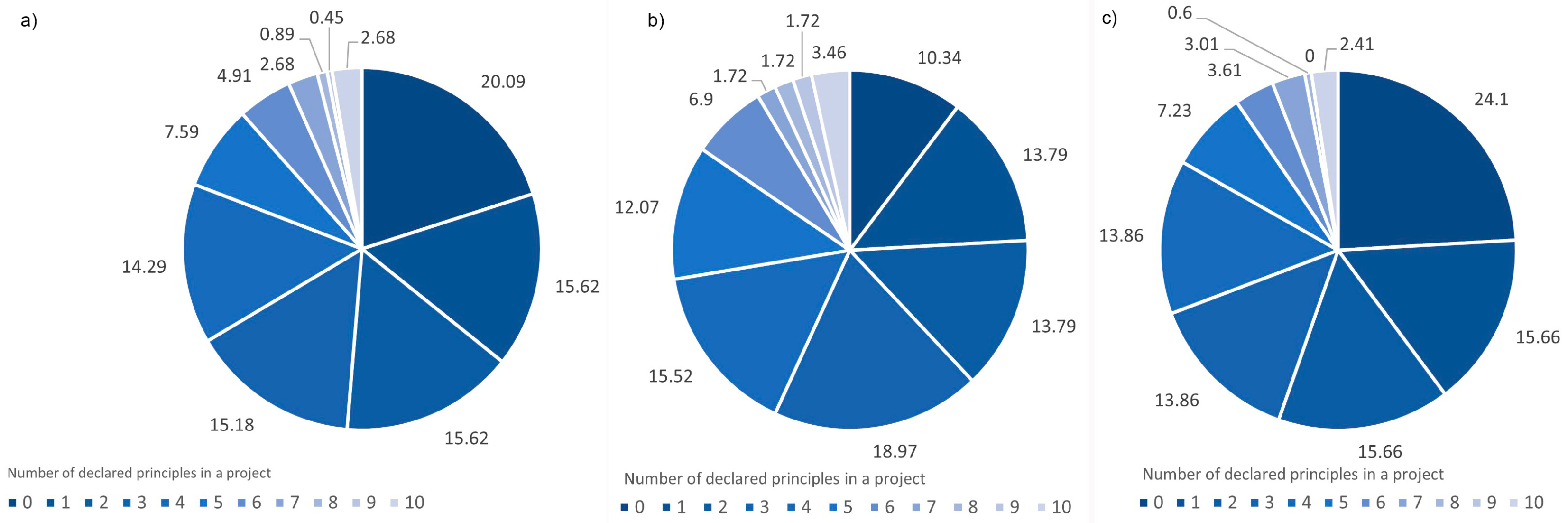
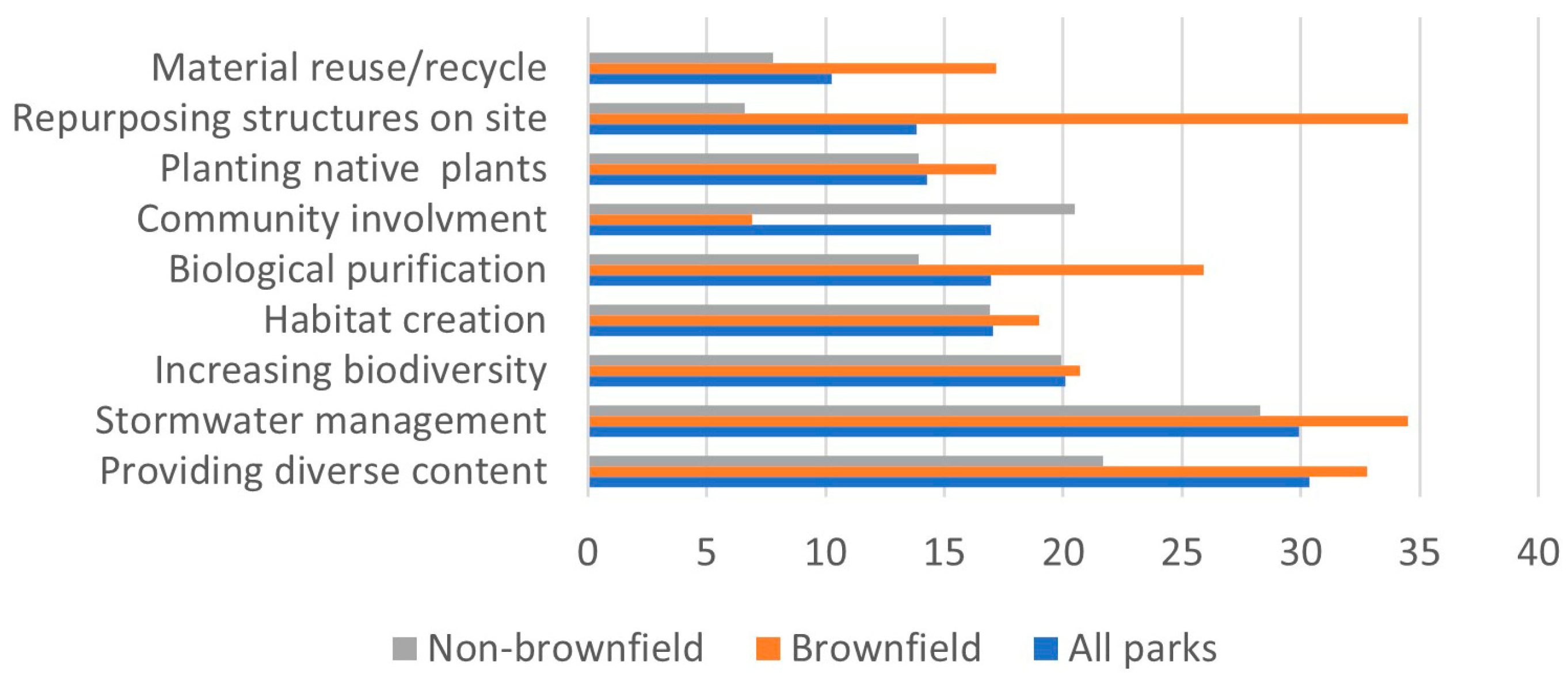

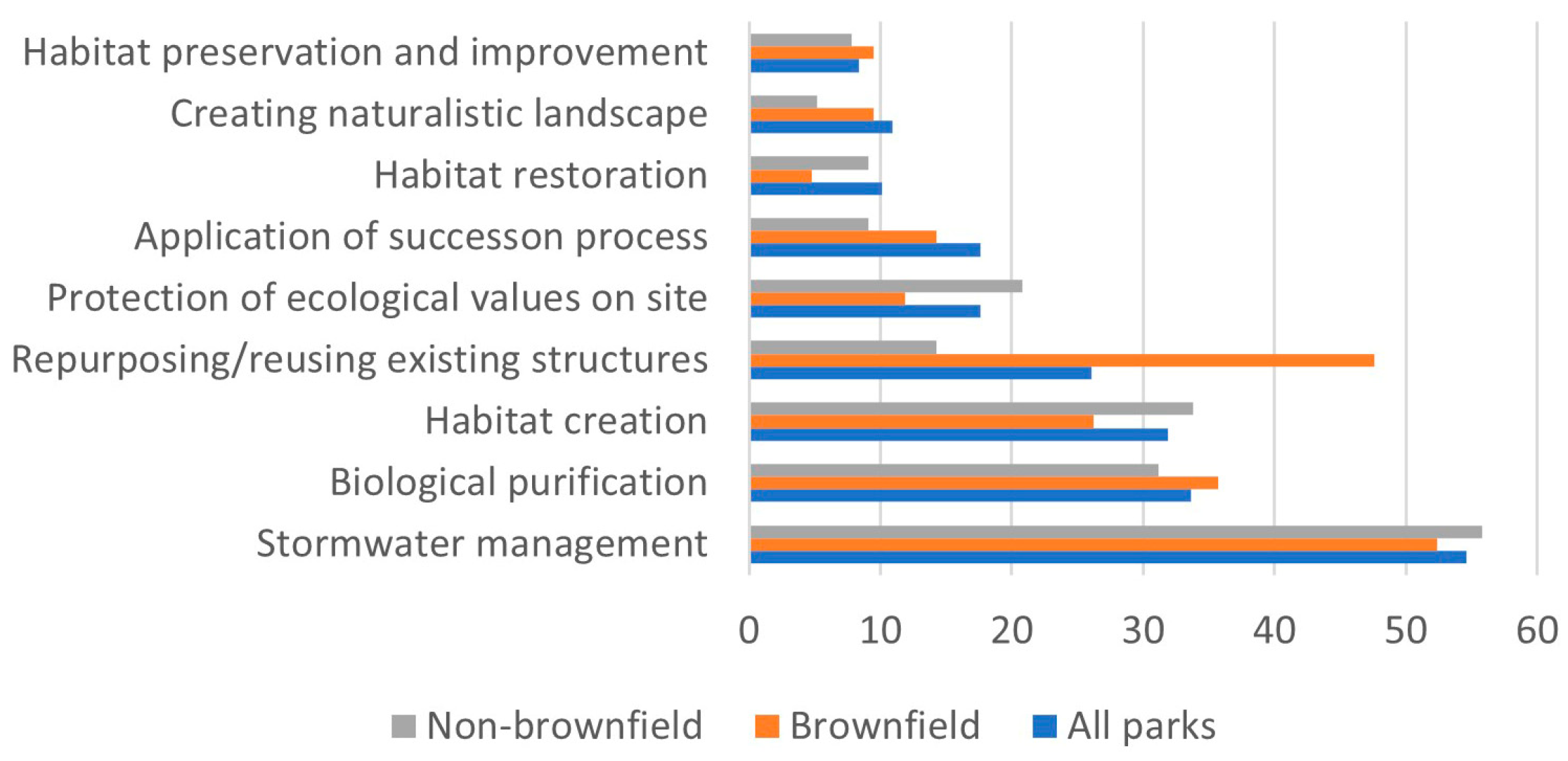
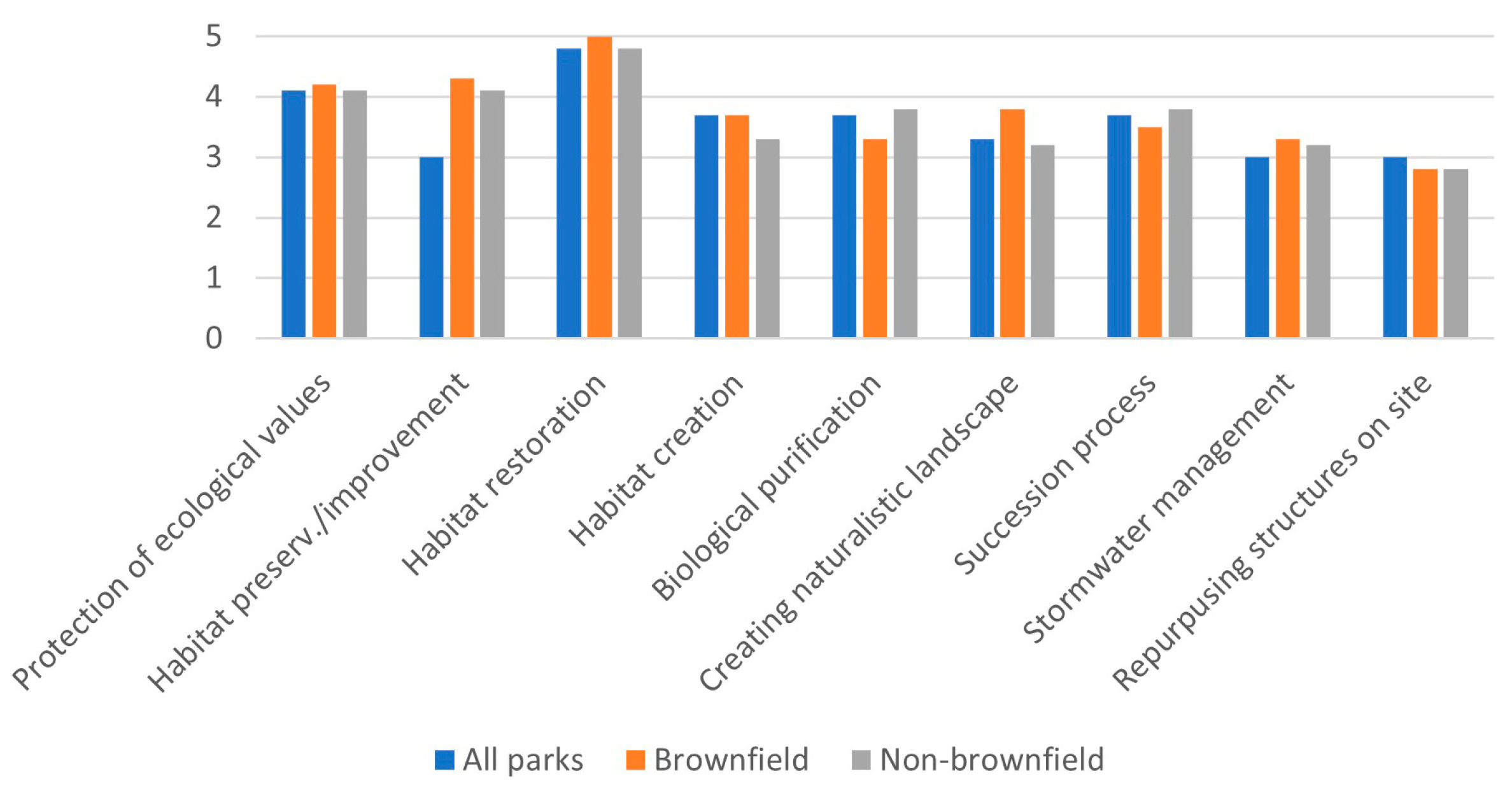
| Score | Impact Level | Description |
|---|---|---|
| 0 | No impact | Principle not expressed at all in the spatial composition |
| 1 | Negligible impact | Principle hardly identifiable in the spatial composition |
| 2 | Low impact | Minor design features reflect the principle in isolated or marginal ways |
| 3 | Medium impact | Principle is integrated into several aspects of the spatial design |
| 4 | Significant impact | Principle informs major compositional structural elements |
| 5 | Paradigmatic impact | Principle is fundamental to the entire design concept |
| Principle Group | Design Principle |
|---|---|
| 1. Ecological restoration of degraded environments |
| 2. Protection of ecological values on site | |
| 3. Habitat preservation and improvement | |
| 4. Habitat restoration | |
| 5. Increasing biodiversity | |
| 6. Ensuring a diversity of natural services for the city | |
| 7. Separation and covering of heavily polluted soil and water | |
| 8. Ecotone design * | |
| 9. Ecosystem connectivity * | |
| 1. Habitat creation |
| 2. Ecological flood control | |
| 3. Biological purification | |
| 4. Maximum infiltration of rainwater | |
| 5. Permeable paving | |
| 6. Improving plant community resilience | |
| 7. Creating a self-sustaining landscape | |
| 8. Creating a naturalistic landscape | |
| 9. Planting native plants | |
| 10. Application of the succession process | |
| 1. Stormwater management |
| 2. Preference for renewable sources and sustainable technologies | |
| 3. Material reuse/recycling | |
| 4. Using sustainable/sustainably produced materials | |
| 5. Cheap/durable materials (concrete and stone) | |
| 6. Repurposing and preserving buildings/structures on site | |
| 7. Low maintenance requirements | |
| 1. Adaptive management approach |
| 2. A systemic approach to design | |
| 3. Community involvement in the design process | |
| 4. Make natural processes visible * | |
| 5. Ecological cost and life-cycle accounting * | |
| 6. Integrated open space | |
| 7. Possibility of education |
| Europe | Asia | ||
|---|---|---|---|
| Country | Projects | Country | Projects |
| Austria | 3 | Israel | 3 |
| Belgium | 5 | Japan | 2 |
| Croatia | 1 | Republic of Korea | 1 |
| Czech Republic | 1 | Kuwait | 1 |
| Denmark | 12 | China | 22 |
| Finland | 4 | Singapore | 2 |
| France | 9 | Taiwan | 4 |
| Germany | 35 | Thailand | 2 |
| Ireland | 2 | United Arab Emirates | 2 |
| Italy | 3 | ||
| Lithuania | 3 | Oceania | |
| Luxemburg | 2 | Australia | 19 |
| Netherlands | 11 | New Zealand | 2 |
| Norway | 5 | North America | |
| Poland | 1 | Canada | 4 |
| Portugal | 2 | USA | 20 |
| Russia | 2 | ||
| Slovakia | 1 | South America | |
| Spain | 7 | Chile | 3 |
| Sweden | 16 | ||
| Switzerland | 4 | ||
| UK | 8 | ||
| Continent | Total Projects | Brownfield Projects | Non-Brownfield Projects |
|---|---|---|---|
| Asia | 26 | 9 | 17 |
| Europe | 67 | 22 | 45 |
| North America | 14 | 6 | 8 |
| Oceania | 12 | 5 | 7 |
| Total | 119 | 42 | 77 |
| Continent | All Parks (avg) | Brownfield Projects (avg) | Non-Brownfield Projects (avg) |
|---|---|---|---|
| Asia | 4.4 | 4.4 | 4.4 |
| Europe | 3.8 | 3.9 | 3.5 |
| North America | 3.3 | 3.5 | 3.1 |
| Oceania | 3.3 | 3.8 | 3.0 |
| Total | 119 | 42 | 77 |
Disclaimer/Publisher’s Note: The statements, opinions and data contained in all publications are solely those of the individual author(s) and contributor(s) and not of MDPI and/or the editor(s). MDPI and/or the editor(s) disclaim responsibility for any injury to people or property resulting from any ideas, methods, instructions or products referred to in the content. |
© 2025 by the author. Licensee MDPI, Basel, Switzerland. This article is an open access article distributed under the terms and conditions of the Creative Commons Attribution (CC BY) license (https://creativecommons.org/licenses/by/4.0/).
Share and Cite
Rechner Dika, I. Are Ecological Design Principles Becoming the Norm in Contemporary Landscape Design? A Comparative Analysis of Realized Park Projects (2015–2025). Sustainability 2025, 17, 6620. https://doi.org/10.3390/su17146620
Rechner Dika I. Are Ecological Design Principles Becoming the Norm in Contemporary Landscape Design? A Comparative Analysis of Realized Park Projects (2015–2025). Sustainability. 2025; 17(14):6620. https://doi.org/10.3390/su17146620
Chicago/Turabian StyleRechner Dika, Iva. 2025. "Are Ecological Design Principles Becoming the Norm in Contemporary Landscape Design? A Comparative Analysis of Realized Park Projects (2015–2025)" Sustainability 17, no. 14: 6620. https://doi.org/10.3390/su17146620
APA StyleRechner Dika, I. (2025). Are Ecological Design Principles Becoming the Norm in Contemporary Landscape Design? A Comparative Analysis of Realized Park Projects (2015–2025). Sustainability, 17(14), 6620. https://doi.org/10.3390/su17146620








